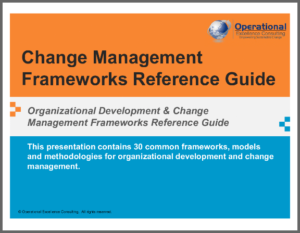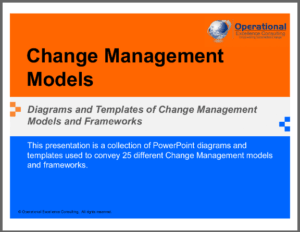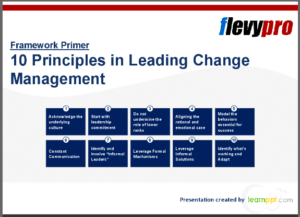Kurt Lewin’s Change Management Model is known for its simplicity. It breaks an organizational change process down into three basic steps.
This post examines the details of the three steps, offers come comparisons with other change models and frameworks, looks at strengths and weaknesses of the Lewin approach, and identifies insights for application by strategists and project managers.
What Is the Kurt Lewin Change Management Model?
Known as Lewin’s Change Management Model, or Lewin’s 3-step model, it was developed by Kurt Lewin (1890-1947), a German-American psychologist. Lewin was considered to be a pioneer in the field of change management.
Here are the three steps:
- Unfreeze – People become aware of the need for change and grow to desire it. ‘Unfreezing’ refers to the idea that the current way of working, and all the cultural and structural underpinnings around it, will be relaxed and prepared for transformation.
- Change – This is the process of transitioning from old ways to a new way of doing business. The organization needs to be ‘prepped’ to transform itself, and needs to execute consistently throughout this stage. Managers need to pay close attention to people and processes, monitor metrics, and adjust accordingly. This stage is complete when the change has been implemented.
- Refreeze – Make permanent the new changes – make them the new normal – preventing reversion back to the old ways. It’s the new way of working. The cultural and structural underpinnings supporting it need to be made permanent. The key is to make certain that the changes are positive and to convince people that the new order is better than previous.
Here is a brief 3-minute video that provides an overview of “Lewin’s Process Model of Organizational Change”:
Let’s go deeper into the three phases of the Kurt Lewin Change Management Model.
Stage 1: ‘Unfreeze’ in Kurt Lewin Planned Change Theory

Both people and the organization need to be prepared for the coming change. Much of this preparation is on the individual emotional level.
Here are key points to handle as part of the Unfreeze stage:
- Identify the need for change – Why is the change needed? A good starting point is to identify where the need for the change is coming from. Is this driven from top down or bottom up? With bottom up, you may already have buy in.
- Clarify the need for change – Repeat…and make it clear why the current way is a dead end and cannot continue. One way is to think about whether the organization will survive if it does not change. That gets attention!
- Sense of urgency – You need to establish a reason why it is urgent to move quickly to make the change. Stakeholders need to be sold on that urgency.
- Assess the current situation – What is the organization’s current financial situation, level of employee stability, quality of customer relationships, and health of ongoing operations? Are they stable and strong enough – and can people believe they are strong enough – to survive the change process?
- Prepare people – It’s the people that must be prepared. What are the culture, attitudes, values, ways of working, and processes? How will each be effected? Be prepared for push back from people…and allow them time to handle it.
- Prepare the organization – Things such as systems, physical plants and offices, and partner and supplier relationships need to be considered also in the face of change. You need to think about reverberations through the entire business model.
- Vision – Clarify the picture of the end state. Clarify also the vision for how the transition will take place. These are important for continuous and consistent communication across stakeholders, especially employees.
The Satir change model and Kubler-Ross change curve provide in depth guidance for preparing people for the natural phases of change. They provide a deeply personalized approach that addresses the emotions.
It is most important to give this phase adequate time. It takes time for people to digest the change and become engaged in a plan for change. Engagement with people must be planned, and regular assessments of readiness can help set the stage for success.
Stage 2: ‘Change’ in Kurt Lewin Planned Change Theory

This is the stage of transition to new ways – of implementing the change.
Here are some key points about the Lewin model in the Change stage:
- Know when to act – Only act to implement the changes once you have assessed that people are ready. You will need to set up metrics – a series of check boxes – that can tell you objectively when people and the organization are ready.
- Clear communication strategy – Communicating throughout the Change process takes logistics, scheduling, and planning. The communications alone is a project unto itself.
- Engage with key influencers – Be strategic about this. In what areas do you need influence, with whom do you need to engage, and what is in it for them? You will need a strategy for getting the Change to take root with these influencers and disseminate to others.
- Empower people – People need to feel they have the tools and support to make Change happen. Remove obstacles, provide continuous support, and communicate constantly.
- Identify quick win projects – What is the ‘low-lying fruit’? What projects provide the most impact for the lowest cost? What projects do we need to complete to lay the groundwork for the next set of projects? Pick projects, in part, based on the ability to demonstrate progress.
- Set the schedule, monitor, and build momentum – Structure the Change initiative as a program. Plan to celebrate wins publicly, and make a point to convince non-believers, as this will eliminate remaining resistance and help to gather increasing momentum.
As with all the steps, this requires deep involvement and constant engagement to assess and adjust activities to navigate through the Change process.
Stage 3: ‘Refreeze’ in Kurt Lewin Planned Change Theory

This phase is about institutionalizing Changes.
Here are key activities in the Lewin Change Model to consider:
- Make the ‘new normal’ permanent – Make it clear that you are not turning back. Better yet, make people convinced that they would not even want to turn back.
- Share metrics – Hopefully the change has been mostly positive and you can show better performance, greater efficiency, or some other kind of improved results from the change. Be transparent with metrics to show all stakeholders what they are accomplishing.
- Assess any issues – There will be issues. Do not expect everything to progress smoothly; there will be rough spots. What has not gone well and not changed as intended? What adjustments need to be made to still gain the main benefits from the Change?
- Build an ongoing support network – Some new structure will be needed to support the Change going forward. Actually, ‘the Change’ will become ‘business as usual’ – but only if support infrastructure is configured properly. Give this some time and be flexible to modify – or accept – what is not working as well as you expected.
- Continue support for the new culture – People will support – or resist – based on their collective behaviors, habits, beliefs, and ways of working. Be persistent with encouraging what you need, and discouraging what is counter-productive, on an organizational level.
Refreezing gives an impression of inflexibility. However, I think some flexibility is needed in order to successfully get through the Refreeze stage.
Kurt Lewin Planned Change Theory and Impacts to Strategy
Strategy is about determining what change needs to be made. While strategy needs to also be concerned with how to implement the change, it is by definition more concerned with the what that the how.
Just as it is important that project managers learn to think more strategically, those working on strategy certainly need to learn to think more about implementation.
—————————————-
I recommend these strategy resources on FlevyPro (paid links):
| Change Management Frameworks Reference Guide 402-slide PowerPoint deck $179.00 |
Change Management Models 136-slide PowerPoint deck $59.00 |

|

|
| 10 Principles in Leading Change Management 17-slide PowerPoint deck $25.00 |
Lean Change Management 21-slide PowerPoint deck $25.00 |
 |
 |
—————————————-
Kurt Lewin’s theories about change and his change management model provides an opportunity to consider implementation issues as part of strategy formulation. Strategies will not work without proper implementation, and having an appreciation for the change management process will help build a more grounded and realistic strategy and timeline.
Two frameworks in particular can be helpful in assessing the organization’s readiness for change:
- McKinsey 7S Framework – This framework identifies linkages among ‘hard’ elements’ – strategy, structure and systems – and ‘soft’ elements – skills, staff, and style. The strategic questions, from the context of the 7S framework and Lewin’s Change Model, are, “What does the organization look like now, before Unfreeze? What does it need to look like to support the Change phase? What is the target 7S configuration needed by the time we Refreeze?”
- Nadler Tushman Congruence Model – Similarly, we can look at the organization, but more from the organizational, team, and individual level. In that context, posing the same questions, “What does it look like now, before Unfreeze? What do we need it to look like to support the Change phase? What is the target configuration at the organization, team, and individual levels needed by the time we Refreeze?”
It is important that change implementation planning is part of the strategy development process.
Project Management and the Kurt Lewin Change Process

The above diagram maps the Kurt Lewin Change Model to the John Kotter 8-step Change Model.
Note that Kotter’s 8-step model is essentially already reduced to three more generalized stages. Working together, these two parallel models can help make implementing change easier. Here’s how:
- Project planning – Project planning begins by laying out the ‘why’ for a project. The answer to ‘why’ needs to be honed into an elevator speech that can be used for consistent communication through the change process – through the Unfreeze, Change, and Refreeze stages.
- Program planning – The phases in Lewin’s model can be refined with the steps in Kotter’s model. Kotter’s steps can be used like more of a checkbox list of what needs to be accomplished before moving on to the next steps and phases.
- Portfolio management – In trying to achieve Change, project selection criteria need to shift in favor of quick wins. There may even need to be some projects created simply to orchestrate getting people and the organization through the different phases of the Change process.
- Scheduling – Schedules need to incorporate time for people to process the Change at each step and phase. Just as it takes time to perform a task on a schedule, it will also take time to Create Urgency, Build Coalition, Create Vision, and all the other steps.
- Risk management – Change is a Risky process, underscored by fear. One of the best ways to dispel the fear is to paint clear pictures of where things are going without the Change, and compare it to where things will go with the Change. You need to clearly communicate that while the Change may feel uncomfortable, the Risk of not Changing is greater!
These are just a few of the key areas where a higher level of awareness of the change management process can help generate more successful projects.
—————————————-
I recommend these PM templates (paid link):

—————————————-
Strengths and Weaknesses of the Lewin Change Model
 Lewin’s Change Model should be considered in light of its strengths and weaknesses:
Lewin’s Change Model should be considered in light of its strengths and weaknesses:
Strengths
- Simple – Easy to remember, communicate to others, and for everyone to relate to
- Easy to focus – People only need to think about accomplishing 3 things
- Forces preparation – Forces you to take time to prepare for the change
- Strong foundation – Focuses people on the fundamentals of change
Weaknesses
- Adaptability – Refreeze step can be questionable given the rapid pace of change today
The Lewin Change Model is great in its simplicity, but may need to be tailored, especially in the Refreeze phase. The ability to adapt – and not necessarily Refreeze – as in a lean innovation scenario, may be critical to consider. It may be helpful to anticipate adaptation that will need to occur in the Refreeze stage.
Conclusion and Further Resources
This post dug into the details of the three steps of the Kurt Lewin Change Management Model, related and contrasted it with several other change models and frameworks, identified strengths and weaknesses of the Lewin approach, and provided insights for strategists and project managers.
What is your experience with the Lewin or other change frameworks in practice?
For a program management perspective, I recommend the following video “Unfreeze, Change, Refreeze | Kurt Lewin’s 3-Step Model”, by Expert Program Management (EPM):
